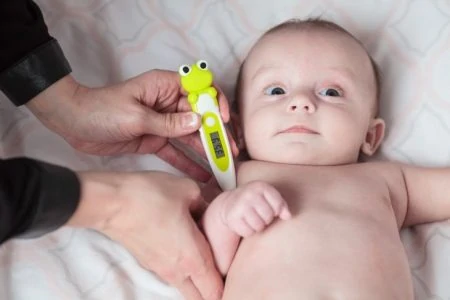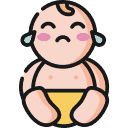Your baby is congested and struggling to breathe, so you know it’s time to administer saline drops to provide some relief. As moms, we understand the dread that goes along with this task. No baby enjoys having anything inserted into their nose.
But we’re here to help you avoid that awful feeling of helplessness when your baby suffers from a cold. Although you can’t treat the cold, you can provide relief for its symptoms (1).
We’ll share what we’ve learned through our personal experience and medical practice and offer our top tips and tricks to help your little one experience relief.
We’ll give you step-by-step instructions to help make the process of administering saline drops more comfortable for both of you. We’ll even provide our recipe for homemade saline drops for babies.
Key Takeaways
- Saline nose drops help relieve baby congestion by reducing inflammation and loosening mucus in their nasal passages.
- Saline drops are safe for babies and can be bought over the counter or made at home using plain kosher salt and distilled water.
- To administer saline drops, place 1-2 drops in each nostril while the baby’s head is slightly angled towards the floor, then use an aspirator bulb to remove loosened mucus.
- Additional techniques to alleviate congestion include using a cool mist humidifier, applying petroleum jelly under the nose, exposing the baby to warm steam, and keeping the baby hydrated.
What Are Saline Nose Drops?
Saline is a saltwater solution used to irrigate the nasal passages and provide relief from swelling and congestion. They are available for purchase over the counter, or you can make a saline solution at home.
Congestion is a side effect of the common cold. Babies only breathe through their nose and do not mouth breath. Nasal congestion thus impairs their breathing, especially while feeding (2).
Why Are They Used for Babies?
Over-the-counter remedies for adults are designed to reduce swelling and allow for easier breathing. While they’re not an option for small children, using a saline solution in the form of nose drops can help reduce congestion.
The salt in the saline solution helps decrease inflammation in the mucous membranes. The solution will also help loosen any blockages while restoring moisture to the sinuses.
Doctors frequently recommend these drops for babies and young children because they don’t contain any medication. They are safe to use on your little one and can provide the relief your baby needs.
Will Saline Drops Help My Baby?
Frequent causes of congestion that would require antibiotics include ear infections and sinus infections. If your child has an infection and may require antibiotics, here are some indicators to look for.
- Ear pulling: Ear discomfort is a classic sign of an ear infection. Babies may cry and pull at their ears. You might notice redness or drainage, but there are frequently no exterior signs accompanying an ear infection. If you suspect an ear infection, bring your child to the pediatrician. They will examine the ear canal and eardrum (3).
- Fever: A fever above 103 F or 39.5 C, especially one that doesn’t respond well to medication or returns repeatedly, may be a sign of a more severe infection (4).
- Thick nasal discharge, especially if it’s colored: While copious discharge may happen during colds, it should be clear and odorless. If you run into thick, green, sludge-like mucus, it’s time to see your doctor.
- Productive coughing: If your child is coughing up mucus, especially if it’s opaque green, it’s worth a doctor’s visit.
- Foul odor: Infections are usually accompanied by odor. If there’s a foul odor, whether it’s coming from the ears, the mouth, or the nose, there’s likely an infection behind it.
Allergies can cause similar problems. If your child has congestion that lingers for more than 10 days, return to your doctor to discuss alternative causes. Your child may need a different treatment plan.
How to Make Saline Nose Drops at Home
You can find saline nasal drops at the drug store and purchase them over the counter.
But what if you need drops suddenly in the middle of the night? You probably won’t want to wrap up your sick child and run to the store.
There’s no need for a special trip — you can make saline nose drops with items you likely already have in the kitchen (5).
Plain kosher salt works best for making these drops. Avoid using salt brands containing additives.
- 1/2 teaspoon (2.5 grams) of salt.
- 8 ounces of distilled or sterilized water.
Mix the ingredients well. You should plan on using your saline solution at room temperature.
How to Give Saline Nose Drops to Your Baby
Once you have your saline nose drop solution, you’ll need to be prepared to administer it. Simply insert one to two drops of solution into one nostril and allow it to travel into the nasal cavity. Repeat on the other side.
This may seem like a tricky task when you have an uncomfortable and squirming child. For best results, try taking the following steps:
- Using an eyedropper, draw up some of the saline solution.
- Lie your baby across your lap with their head angled slightly toward the floor so you can use gravity to help the saline solution get where it needs to be.
- Place one to two drops in each nostril.
- Allow your baby to remain reclined for a few minutes if possible. This may encourage sneezing, which will help loosen and remove mucus and congestion.
- Using an aspirator bulb, gently remove any newly loosened mucus. Squeeze out all the air in the bulb before inserting it in your baby’s nostril and slowly releasing the pressure.
Use the nasal drops prior to feeding so your baby can still breathe through their nose. Don’t use the nasal drops more frequently than every 3 to 4 hours.
Safety Precautions to Take
When administering the drops, follow some basic safety precautions:
- Make sure your hands and all the equipment are clean. Always wash your hands thoroughly before and after application to limit germ transmission. You should sterilize your eyedropper and aspirator bulb after each use.
- If your child begins to cough, allow them to sit up.
- Weakness, lethargy, trouble breathing, and an irregular heartbeat are never normal and require immediate medical attention.
Tips for Navigating Congestion
In addition to using saline nose drops for your child, these are some techniques you can use to help lessen congestion:
- Use a cool mist humidifier to moisten the air.
- Apply petroleum jelly gently under the nose to help prevent raw, chapped skin.
- Use warm steam from a hot shower to loosen trapped mucus. You can hold your baby with the door closed in your bathroom as the water runs in the shower.
- Keep your baby hydrated.
While you can’t shorten the length of the common cold, you can make it more comfortable for your child (6). These techniques, combined with the use of saline drops, could make a big difference for your baby.














